 W
WKoonwarria manifrons is an extinct prehistoric ray-finned fish that lived in a polar lake in what is now Koonwarra, Victoria, Australia. Fossils have been retrieved from the Strzelecki Group.
 W
WAmegilla asserta is a species of bee endemic to Australia, belonging to the family Apidae subfamily Apinae. Females forage by performing buzz pollination.
 W
WThe Australian sprat is a sprat fish whose habitat ranges in the waters surrounding Australia including Tasmania. They can grow to 14 cm. Their depth range is from 0 to 50 m. They often enter estuaries.
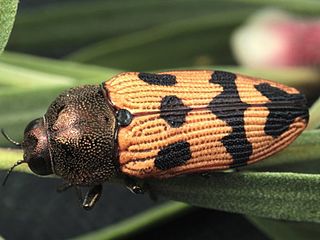 W
WCastiarina turneri Barker 1983 is a beetle in the Family Buprestidae, otherwise known as jewel beetles. The species was described by Dr Shelley Barker, OAM, in 1983.
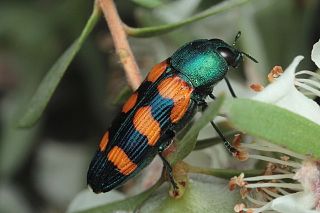 W
WCastiarina vegeta is a beetle in the Family Buprestidae, otherwise known as jewel beetles. The species was described by Hope in 1847.
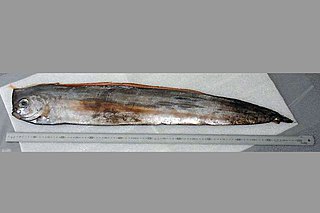 W
WThe crested bandfish is a species of crestfish in the family Lophotidae. It has a long string-like body, with large eyes, a red dorsal fin, elongated leading rays, and a short anal fin near the caudal fin. It grows up to 2 metres in length.
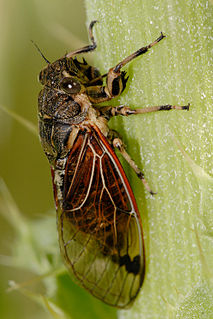 W
WDiemeniana frenchi is a species of cicada in the Cicadinae subfamily, native to Victoria and New South Wales in Australia. It was described by William Lucas Distant in 1907.
 W
WThe eel-tailed catfish, Tandanus tandanus, is a species of catfish of the family Plotosidae. This fish is also known as dewfish, freshwater catfish, jewfish, and tandan.
 W
WHesperilla chrysotricha, the chrysotricha skipper or goldenhaired sedge-skipper, is a butterfly of the family Hesperiidae. It is found in the Australian states of Victoria, Tasmania, South Australia and Western Australia.
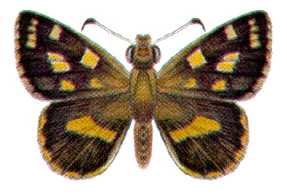 W
WHesperilla crypsargyra, the silvered skipper or silver hedge-skipper, is a butterfly of the family Hesperiidae. It is found in the Australian states of New South Wales, Queensland and Victoria.
 W
WHesperilla flavescens, the yellow sedge-skipper or yellowish skipper, is a butterfly of the family Hesperiidae. It is found in the Australian states of South Australia and Victoria.
 W
WNotolabrus fucicola, the banded parrotfish, blue wrasse, kelpie, New Zealand banded wrasse, purple parrotfish, saddled wrasse, Southern purple wrasse, Southern wrasse, winter bream or yellow-saddled wrasse, is a species of wrasse native to the eastern Indian Ocean, off eastern Australia and all around New Zealand on rocky, weedy reef areas. Aging work in New Zealand suggested these wrasses can live at least 35 years.
 W
WThe red codling or hoka is a morid cod of the genus Pseudophycis, restricted to New Zealand, from the surface to 700 m. A closely related species is found in Australia. Its length is up to 90 cm. P. bachus is a food source for the diving yellow-eyed penguin, Megadyptes antipodes.
 W
WThe small-headed cod or the long-finned cod is a deepwater fish belonging to the morid cod family (Moridae), and related to the true cods. It is found in the Tasman Sea, including the Bass Strait. It is commercially harvested by both Australia and New Zealand. It has been found on the continental shelf, but typically its depth range is from 750 to 1,000 m. It grows to 48 centimetres (19 in) in total length.
 W
WThe spiny pipehorse is a pipefish of the family Syngnathidae, found in the southwest Pacific Ocean on rocky or coral reefs to depths of 230 metres (750 ft). Length is up to 50 centimetres (20 in).
 W
WThe glassy sprat is a type of sprat fish. The fish, when alive, is translucent, so it gets the second word in its scientific name from the Latin word translucidus, meaning transparent, diaphanous. In animal classification the glassy sprat belongs to Osteichthyes(some resources classified as Actinopterygii), Clupeiformes, Clupeidae, Hyperlophus. The glassy sprat is native to Australia and mainly found in Australia. It is marked as NE because it has not yet been evaluated by the World Animal Protection. It is mainly used as an economical aquatic product. In ecosystems they are at the bottom end of the food chain, feeding mainly on plankton, which are less aggressive and very vulnerable to other fish. Glassy sprat are tiny in size and translucent with a silvery streak that extends from its tail to just behind its head. As early as a hundred years ago, Australians harvested the glassy sprat in large quantities and it featured on the table as food for a long time. Due to its poor appearance, it is not a very good ornamental fish.
 W
WThe crossback stingaree or banded stingaree is a species of stingray in the family Urolophidae. It is endemic to southeastern Australia, mainly off Victoria and Tasmania but also marginally to New South Wales and South Australia. This bottom-dwelling fish generally inhabits sand and reef habitats deeper than 100 m (330 ft) off Victoria, and muddy habitats in shallow bays and estuaries off Tasmania. Befitting its name, the crossback stingaree has a distinctive dark pattern on its back, consisting of a midline stripe that is crossed by three transverse bars. It has an oval pectoral fin disc with a blunt snout and a skirt-shaped curtain of skin between the nostrils. Its tail is short with no skin fold along the sides, and a deep, leaf-shaped caudal fin. The youngest rays may have a small dorsal fin in front of the stinging tail spine. This species reaches 50 cm (20 in) in length.
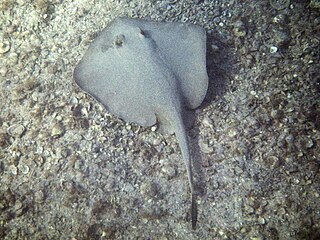 W
WThe greenback stingaree is a little-known species of stingray in the family Urolophidae, endemic to the outer continental shelf and upper continental slope off southeastern Australia. Growing to a length of 51 cm (20 in), this species has a diamond-shaped pectoral fin disc wider than long and uniformly light green in color above. Between its nostrils is a skirt-shaped curtain of skin. Its tail bears skin folds on either side and a deep, lanceolate caudal fin, but lacks a dorsal fin.
 W
WThe sandyback stingaree or great stingaree is a little-known species of stingray in the family Urolophidae, endemic to southeastern Australia. It is generally found offshore around the edge of the continental shelf, at a depth of 65–265 m (213–869 ft). A relatively large species reaching 89 cm (35 in) long, the sandyback stingaree has a diamond-shaped pectoral fin disc wider than long, usually with a dorsal pattern of numerous fine lighter marks on a yellowish to brownish background. Its short tail terminates in a deep, leaf-shaped caudal fin, and bears a sizable dorsal fin just in front of the stinging spine.
 W
WThe eastern shovelnose stingaree is a species of stingray in the family Urolophidae, endemic to coastal waters off southeastern Australia, excluding Tasmania. This species has a rounded pectoral fin disc wider than long, a fleshy snout forming an obtuse angle, and a relatively short tail terminating in a caudal fin. Its nostrils have prominent lobes on their outside rims and a skirt-shaped curtain of skin with a strongly fringed trailing margin between them. The dorsal coloration is mostly plain brownish, occasionally with a scattering of darker and/or lighter spots. One of the larger stingarees, it can grow to at least 80 cm (31 in) long.
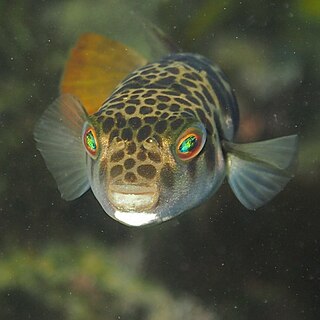 W
WThe smooth toadfish is a species of fish in the pufferfish family Tetraodontidae. It is native to shallow coastal and estuarine waters of southeastern Australia, where it is widespread and abundant. French naturalist Christophe-Paulin de La Poix de Fréminville described the species in 1813, though early records confused it with its close relative, the common toadfish. The two are the only members of the genus Tetractenos after going through several taxonomic changes since discovery.
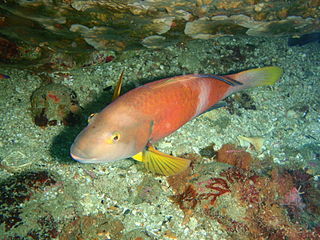 W
WThe blue-throated wrasse, also known as the bluehead, bluehead parrotfish, bluenose, bluenose parrotfish, bluethroat parrotfish, blue-throat wrasse, kelpie, lilac banded parrotfish, rocky bream, rocky cod, rotfish or winter bream, is a species of marine ray-finned fish from the family Labridae, the wrasses. It is found in the Indian and Pacific Ocean off the south-eastern coasts of Australia.